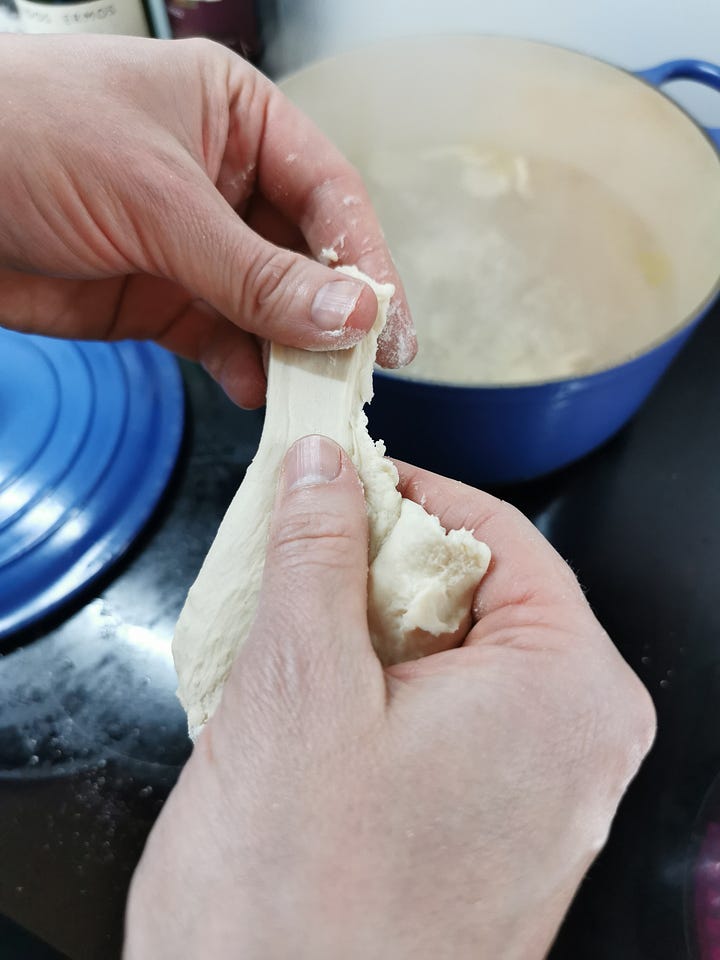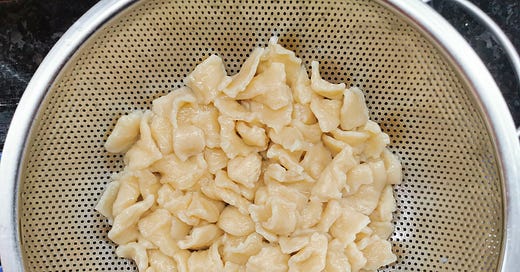How to Make Fresh Pasta Quicker Than Boiling Dried
Welcome to the world of Croatian Trganci
Welcome to The Sauce (formerly the Capsule Pantry), deep travels through food and drink culture written by Charlie Brown, founder and former owner of what was once named Britain’s best independent wine store.
The Sauce is 100% reader-supported. For $5 a month or $50 a year, you’ll get access to hundreds of recipes and an ever-increasing number of food and wine commentaries and articles, as well as discounts on my remote wine consulting service.
I’ll teach you how to cook better. How to buy better drinks. How to cope with wine culture when it threatens to overwhelm you.
Your donation keeps the oven on and the pantry stocked. Thank you.
I haven’t bought a pack of pasta in over a year.
Honestly, I never liked the dried stuff very much. Convenient yes, but even the alleged quality brands tend to overcook in a matter of seconds rendering it slimy and smushy.
Fresh pasta is a different beast but frankly, I’m a little scared of it. It takes forever and is easy to ruin. Besides, I no longer own a pasta maker or one of those big nonna-approved rolling pins.
And store-bought fresh pasta? That stuff is even worse than dried.
Then a couple of years ago whilst traveling around Croatia in the first year glow of my post-business sale, I discovered Trganci.
Pronounced Tur-gan-see, Trganci is a fresh pasta from a little-known Croatian region called Slavonia. Slavonia makes up a big part of the northern inland part of the country that nobody ever visits.
Including, I have to admit, me.
But I quickly discovered that some of the best Croatian food comes from Slavonia including the black Slavonian pig (talk about primo-level charcuteries) to these little squares of fresh pasta.
The food is so good, it’s spread across Croatia so even unadventurous tourists like me get to try the bounty of the county.
Trganci pasta is so good — and so quick to make — it’s completely replaced my dried pasta store. All I need is a bag of decent flour in my pantry and fresh pasta is mine as little as 10 minutes after coming up with the idea.
This is an eggless pasta. All it takes is flour, salt, hot water, and a little olive oil. Knead it into a dough for a few minutes whilst the kettle boils. Pick off little squares of dough and drop them into salted boiling water.


Three minutes later, you’ve got fresh pasta on your plate.
That’s about 10 minutes in all —less time than it takes for dried pasta to boil.
And infinitely better.
Whilst you could argue that the best flour to use here is 00 — the backbone of Italian pasta — the beauty of Trganci is that it doesn’t matter all that much. If you’ve got plain old all-purpose white flour in your pantry, that will work, as will strong white bread flour.
So long as it’s white and wheat-based, it should work a treat.
Aim for around 60% hydration — the weight of water should be 60% of the weight of flour (100g of flour = 60ml of water). Any higher and your dough may feel light and stretchy but tearing off pieces will become a sticky nightmare.
The temperature of the water used to form the dough is not especially important but I like to use hot-from-the-tap, especially if it’s a cold day.
Trg in Croatian means square — specifically a town square — and whilst I’ve never been able to back this up, I’m assuming that’s why the little bits of pasta you tear off are meant to be square-shaped. Whilst back in the day I would carefully tear off little bits, squash them out and make sure they were roughly square, nowadays I’m less fussy about it. Whatever shape the pasta tears off in my hand is what gets dropped into the water.
This pasta is very forgiving. If you undercook it, it’ll have a nice chew. Overcook it and it’s not terrible either.
The usual tips for making fresh pasta apply here:
Heavily salt your pan of boiling water.
Don’t use a huge pan for the boil. The lower the water-to-pasta ratio, the starchier the water will be. You want that starchy water to help bind the pasta and the sauce together at the end.
Always finish cooking the pasta in your sauce, adding reserved pasta cooking water as needed. The starch in the pasta water will thicken the sauce and bind it better than you could ever get by keeping the sauce and pasta separate.
Today, I’m giving you the OG trganci pasta recipe. If you’re a paying subscriber, you’ll also get three tomato-sauce-based ways to use it:
Goulash
Meat ragú
Sausage and fennel
Trganci
Makes enough for 4 people
300g / 10.5oz white flour
Hot water at 60% the weight of the flour (180ml or 6 fl. oz)
2 tsp fine sea salt dissolved in the water
1 tbsp olive oil
Mix all the ingredients until it forms a dough.
Knead for 2-3 minutes, adding more flour to your work surface if it’s too sticky.
Optional step - let the dough rest in a covered bowl for 20-30 minutes. Not essential if you’re shot on time.
Get a pan of water on the boil. Add a hefty few pinches of salt.
Split the dough into rough quarters. Roll them into a ball in your hands and flatten out into a disk. Pinch small pieces off the dough.
Either drop them directly into the boiling water as you go (good if you’re making a small amount or you have another pair of hands to help) or onto a floured surface, ready to scoop up and into the boiling water in one go once you’re ready.
Simmer the pasta for 2-3 minutes.
Drain, reserving some of the water (I put a mug into the sink and drain the pasta directly over it to catch the water below).
Add the pasta to your sauce. Simmer in there for another minute or two, adding starchy pasta water tablespoon by tablespoon as it cooks until you have a thick, silky sauce.
Whilst the recipe for Trganci is reasonably set (you can’t muck about with hydration levels too much and I’ve never found it works as well with other flour types), you can use it in about as many variations as your brain can muster.
All of these three recipes are made from a similar tomato and meat base. The quality of your tomatoes is key here. Buy as good a quality as you can afford.
Meat ragú
Keep reading with a 7-day free trial
Subscribe to The Sauce to keep reading this post and get 7 days of free access to the full post archives.







